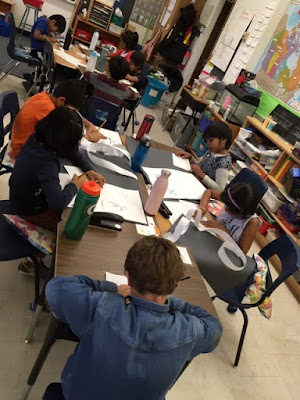




This week the children finished their time capsule books, made spiders, talked about the relationships between days/weeks/months/years, learned about the history and traditions of Halloween and much more!
In math, the class has begun the unit on measurement by talking about the relationships between days/weeks/months/years. For example, there are 365 days in a year. Some time measurements have a science reason for the amount of time, for example, a year or 365 days is the amount of time it takes for the Earth to make one complete trip around the sun.
Later in the week, the students learned about ordinal numbers. Ordinal numbers indicate the order of things (e.g, fifth or 5th). Regular numbers are called cardinal numbers (e.g, 1, 2, 3). This fits in with calendar dates as the numbered day of the month often uses the ordinal number, for example, Friday, November 1st.
On Halloween, the children did some "spider math" based on the 20 spiders that the class made. They were asked to figure out how many spider bodies there were, how many spider eyes and how many spider legs altogether. They were also asked to write about how they got their answers. This is an example of an applied knowledge activity. There was no lesson as students were expected to "use what they know" to help them. For example, many children used skip counting, some children did the math for one desk group and then added the totals for the four desk groups in our room.
In writing, the children finished their time capsule books documenting some things about themselves, like their age and height. The students also had a photo taken and were given a "lucky nickel" to put in their little books. Later in the week the class wrote a large letter to "The Future Room 222" documenting some of the activities that we have done so far this year. After learning how to write a letter, each child wrote a letter to their future selves and put the letter in his/her time capsule book. At the end of the week the class put all the books, the class letter and "Flash Domo" in a box and sealed it up with lots of tape. We will open the time capsule on the last day of school, June 25, 2020.
The students wrote short stories about the spiders that they made. However, the "twist" this time was to write the story as if the spider was talking. This is called a first person narrative. For example, the story might begin, "Hello! I am Boris the spider. I live in England and I am a pizza chef."
In our guided reading groups, the children finished chorally reading the second half of, "Moira's Birthday". The learning goal with this book was to read with expression and use the text features in the book like capital letters and exclamation marks, to help them read aloud.
In science, the children continued the unit on Air and Water in the Environment by talking about the different states of water in The Water Cycle. There is only so much water on Earth and so it is constantly being recycled through evaporation-condensation-precipitation. The students did a short experiment by having a large drop of water on each of their desks. The next morning, the drop of water was gone. Where did it go? The water evaporated into the air by going from a liquid to a gas. Did you know that fog is really a cloud on the ground and a cloud has drops of liquid water in it?
The class started to learn about the air around us. The children chorally read some text about air and how living things use air. Then they completed content questions using the information in the text. Did you know that animals breathe in oxygen and breathe out carbon dioxide and plants do the
opposite during the day, by taking in carbon dioxide and releasing oxygen? That's why plants and trees are so important on Earth because they constantly release the oxygen that humans and animals breathe.
In social studies, we are slowly going to go through the unit on Traditions and Celebrations this term. Some traditions are observed by lots of people and some are simply family or local traditions. Halloween was a great opportunity to talk about the history of this celebration and the symbols and traditional activities done at this time of year. Did you know that the word "Halloween" comes from the original Christian observation of the day before "All Saints Day" or "All Hallows Eve" which over the years was shortened to "Halloween"?
Our time capsule project is an example of a local tradition in my classroom. Every year my class does this project, but not every class does. It's also a class tradition to put "Flash Domo" inside the box to protect the little books until we open the box on the last day of the school year.
In art, the students created beaded spiders by counting out materials and following directions. This was a great activity for developing fine motor skills as counting out the 32 beads and threading them on pipe cleaners in a specific pattern was a lot to remember. Later in the week, the children learned how to fold origami paper "claws". (This origami model can also be used to make finger puppets.)
Please see more Halloween photos and information in a separate posting.
We also planted an amaryllis flower bulb and are measuring how tall it is each day to observe its growth.
Books read aloud this week:
Nate the Great and the Halloween Hunt by Marjorie Weinman Sharmat
Halloween Is... by Gail Gibbons
The Tailypo by Joanne Galdone
The Secret Birthday Message by Eric Carle
Moira's Birthday by Robert Munsch (finished)



























